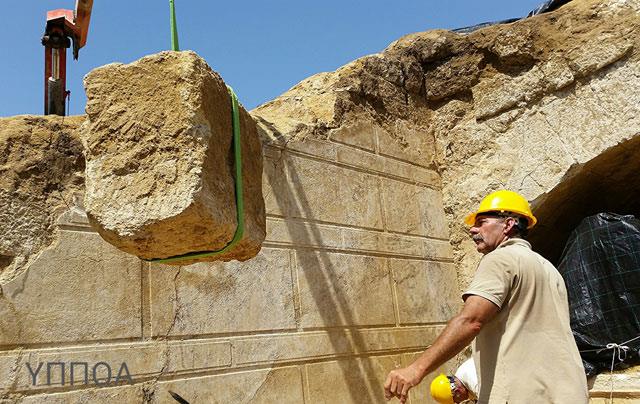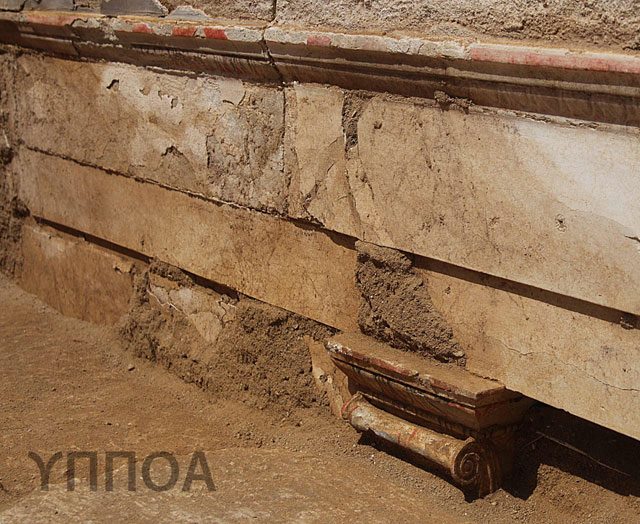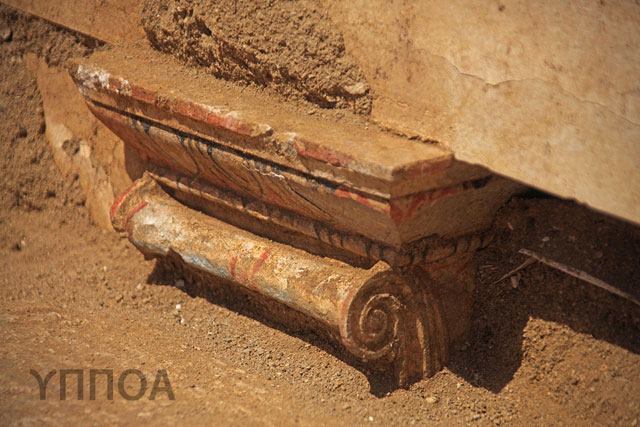The excavations of the burial mound in Amphipolis are continuing at a fast pace, but mostly with due care. On Wednesday archaeologists completed the operation to remove the 11 marble blocks, thus completely uncovering the sphinxes guarding the entrance of the tomb. Each of the statues that are placed opposite each other is 1.45 metres high and weighs 1.5 tons. They were made of Thassos marble and archaeologists believe that the same master had cut both the sphinxes and the statue of the Lion of Amphipolis that had adorned the top of the tomb.
The wings of the sphinxes have been found during the excavations, but not their heads with which they will become 2 metres high. Traces of red paint have been found on their feet as well. The bodies of the sphinxes were processed with a very fine chisel which is how the master achieved the plasticity and the fine craftsmanship of the statues that date back to the last quarter of the 4th century BC.

So far, archaeologists have not found the ancient workshop where the statues were cut nor have they established whether it was located near the area of Amphipolis or farther. They are however adamant that the statues of the sphinxes were painted all over and finding their wings will allow their overall restoration.
Having removed the soil at the entrance, archaeologists have uncovered a small part of the upper of the tomb where there are also traces of red and blue paint in two shades. The finding, however, is not associated with their assumptions that they may find a wall painting inside that will reveal the identity of the deceased.
 Archaeologists have reached the level of the inside of the dome where their task is to ensure the stability of the marble blocks in order to remove the soil. Each block weighs approximately 250 kg and it is not yet clear whether they will be removed. The team led by Catherine Peristeri will decide that once they have removed the soil from the front of the tomb and from behind the sphinxes. The excavations are taking place in the presence of Secretary General of the Ministry of Culture Lena Mendoni.
Archaeologists have reached the level of the inside of the dome where their task is to ensure the stability of the marble blocks in order to remove the soil. Each block weighs approximately 250 kg and it is not yet clear whether they will be removed. The team led by Catherine Peristeri will decide that once they have removed the soil from the front of the tomb and from behind the sphinxes. The excavations are taking place in the presence of Secretary General of the Ministry of Culture Lena Mendoni.
Minister of Culture Konstantinos Tasoulas in turn states that the interior of the tomb will be uncovered soon. According to him, the archaeologists want to fully ensure the stability of the monument before reaching its interior.
At the same time, the Ministry has announced that the Greek state natural gas company DESFA will donate 30,000 euro in the form of funding for the archaeological excavations in Amphipolis.
The latest announcement of the Ministry of Culture informs that archaeologists have removed the soil that was between and behind the sphinxes, with a depth of about 2 metres and a width approximately equal to the entrance of the tomb, 4.5 metres, thus completing most of the work related to the clearing of the interior of the dome.

At the same time, five stone blocks have been removed, with the use of mechanical means, from the sixth row of the wall that seals the tomb, uncovering the top of a marble door under the base of the sphinxes. It is covered with frescoes resembling Ionic architrave and with decorations in red, blue and black. Two Ionic capitals of the pilasters of the door, also covered with frescoes and painted in the same colours, have been found right under the architrave too.


Archaeologists will continue their work tomorrow and their main task will be to secure and restore the artefacts found today.